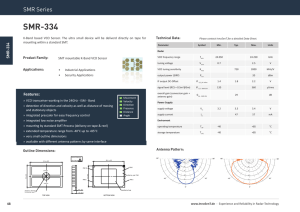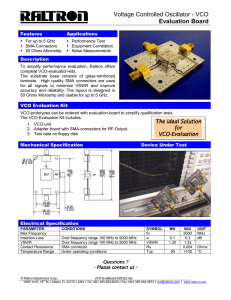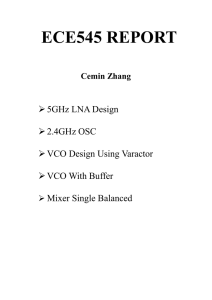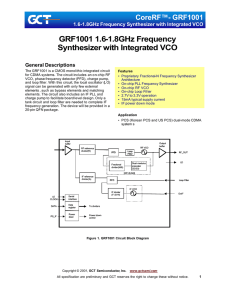High-tuning range VCO
advertisement
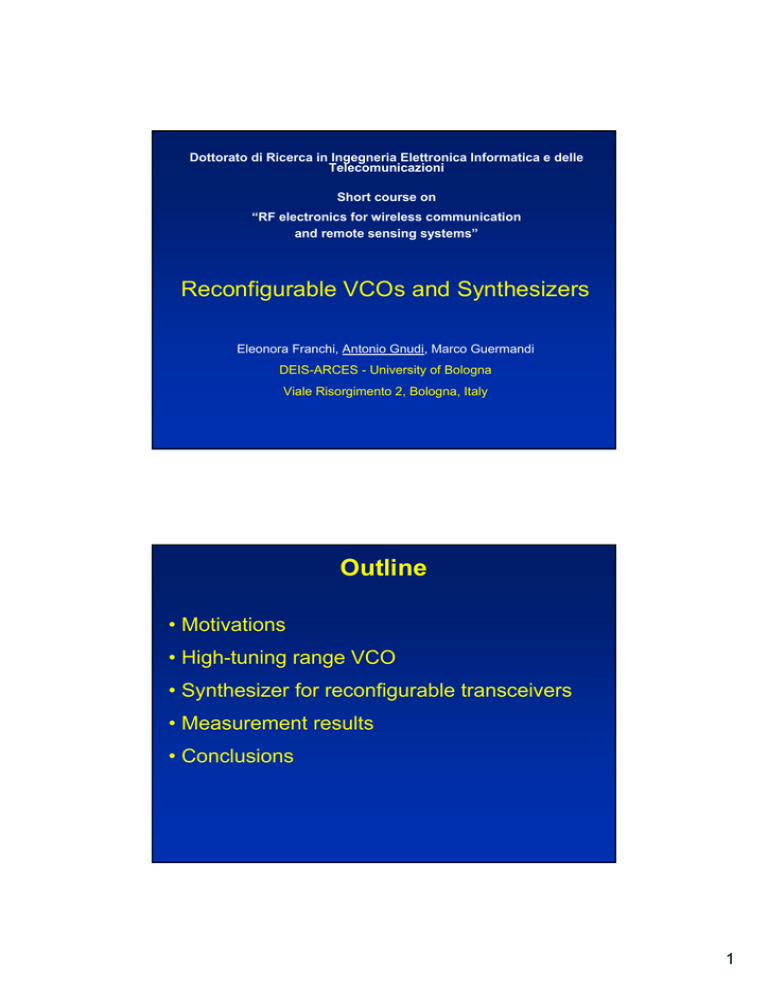
Dottorato di Ricerca in Ingegneria Elettronica Informatica e delle Telecomunicazioni Short course on “RF electronics for wireless communication and remote sensing systems” Reconfigurable VCOs and Synthesizers Eleonora Franchi, Antonio Gnudi, Marco Guermandi DEIS-ARCES - University of Bologna Viale Risorgimento 2, Bologna, Italy Outline • Motivations • High-tuning range VCO • Synthesizer for reconfigurable transceivers • Measurement results • Conclusions 1 Motivations Frequency synthesis for multi-standard transceivers requires: ¾ wide frequency range ¾ versatility in channel spacing ¾ high switching speed … all this with low phase-noise and low cost ! Available solutions ¾ wide frequency range • VCO + dividers when possible (multiband) • switched tanks (L or C) or switched VCOs • technology boosters (bond-wire inductances or high CMAX / CMIN ratio capacitors) • VCOs + mixers for frequency shift (UWB) ¾ versatility in channel spacing & switching speed • fractional-N PLL • reconfigurable loop-filter 2 Investigated solutions ¾ wide frequency range • high-tuning range single-LC VCO • designed for 0.9-2.4 GHz continuous tuning ¾ versatility in channel spacing & switching speed • fractional-N PLL with linearization and spurs cancellation techniques to break the bandwidth trade-off Main concept of high-tuning range VCO α γ 0.5 0.33 0.2 0.11 3 2 3/2 5/4 1+α γ = 1−α 3 Problems with the previous concept γ = 2 (1 FF), α = 0.33 … too much for a common LC VCO • For • For α = 0.2 (achievable for LC VCO), γ = 3/2, but what about the duty cycle? α γ 0.5 3 0.33 2 0.2 3/2 0.11 5/4 Fvco Ideal Fvco/(3/2) with 50% duty-cycle Realistic Fvco/(3/2) with duty-cycle not good for mixer More problems • For I/Q mo-demodulation, both in-phase and inquadrature LO signals are required • A multiplexer is necessary for the selection of the output frequency sub-band A more effective solution is required !! 4 High-tuning range VCO: architecture 0.83-2.5 GHz 2.5-3.75 GHz (±20%) High-tuning range VCO: configuration A 0.83-1.25 GHz 2/3 Fvco Fvco 1/3 Fvco 1/3 Fvco 5 High-tuning range VCO: configuration B 1.25-1.87 GHz Fvco Fvco 1/2 Fvco DC High-tuning range VCO: configuration C 1.67-2.5 GHz 4/3 Fvco Fvco 1/3 Fvco 2/3 Fvco 6 Schematic of the core LC-QVCO ILO • 5-bit capacitor array for coarse tuning • amplitude control The quadrature is obtained by two Injection-Locked Oscillators (ILO) coupled by second harmonic Some theoretical results on the QVCO Stability of the solutions: “low swing” regime: Is1 Is2 in-phase Vd1 Vd2 in-phase “high swing” regime: Is1 Is2 opp.-in-phase Vd1 Vd2 in-quadrature Quadrature oscillation is stable in the “high-swing” regime, that is also beneficial for low phase noise 7 QVCO explanation (1) Stable solution QVCO explanation (2) Stable solutions: depending on Is0 two possible regimes VS and IS opposite in phase: Quadrature obtained 8 More theoretical results on the QVCO Phase-noise analysis QVCO Single stage ILO R 1 ω0 r θ n1 = ⋅ ⋅ ⋅ inQ Vdm Q j 2ωn r r θ n1 = ω r R 1 ⋅ ⋅ 0 ⋅ inQ Vdm 2Q j 2ωn The QVCO and the single stage ILO have the same phase-noise x current product More theoretical results on the QVCO Sensitivity to tank mismatches err = 3Q I s 0 1 ω01 − ω02 ⋅ + ⋅ 4 I sm 3 ω0 The quadrature error is proportional to the ratio of the bias current over the coupling current and to the quality factor Q In the proposed scheme the output I/Q signals are generated by the DIV2 an extremely low I/Q error is NOT required from the QVCO 9 High tuning VCO: circuit design style • SCL logic for low sensitivity to parameter variations (differential style) • Adjustable bias current across the different sub-bands • Differential Gilbert cells for the SSB mixer. D-latch used in the MS-FF DIV2 Feedback path: DIV2 and MUX DIV2 Constant output Buffer 10 Schematic of the SSB mixer compensation for 50% duty-cycle Effect of the duty-cycle compensation Mixer outputs from simulations: w/o compensation with compensation 11 Chip micrograph STM 0.13 µm CMOS technology Summary of measured high-tuning range VCO performance Configuration A (1/3) B (1/2) C (2/3) Freq. range (GHz) 0.83 /1.25 1.25 /1.87 1.67 / 2.5 PN @ 1MHz (dBc/Hz) -130 / -126 -127.5 / -122.5 -126.5 / -120 LC-QVCO curr. (mA) 22.1 / 12.25 22.1 / 12.25 22.1 / 12.25 Reconf. curr. (mA) Total current (mA) Quadrature accuracy 9.5 31.5 / 21.7 < 2° 5.3 27.5 / 17.6 < 1° 8 30.1 / 20.2 < 1° 12 Phase-noise measurements C (2 GHz) A (1 GHz) Meas. 0-3 GHz spectrum: configuration A 13 Meas. 0-3 GHz spectrum: configuration B Meas. 0-3 GHz spectrum: configuration C 14 Possible origin of the subharmonic spur in configuration C At the mixer output: fund. @ 4/3 Fvco + tone @ Fvco (1/3 Fvco offset) At the divider output: fund. @ 2/3 Fvco + tone @ 1/3 Fvco (same offset) Below -35 dBc in worst case over full frequency range Synthesizer for reconfigurable transceivers The classical integer-N architecture … high-tuning range VCO … is not adequate for channel spacing and switching speed 15 Σ∆ fractional-N synthesizer N/N+1 high-tuning range VCO b(t) = …001110101… Fractional-N obtained by varying the division ratio with a proper control sequence (α = <b(t)>): Fout = Fref x (N+α) Why fractional synthesis? • Easier trade off between reference frequency, loop bandwidth and output frequency resolution. – The reference frequency can be higher than channel spacing ⇒ Increase of the loop bandwidth. • Fine frequency step. – The frequency resolution can be much smaller than the reference (varying α=<b(t)> in very fine steps) • Multistandard receivers. – Reference frequency is independent on channel spacing 16 First order Σ∆ • Assuming a constant input: – The output mean is equal to the input – The quantization noise is high-pass shaped (see explanation on next slide) Noise shaping in first order Σ∆ General Σ∆ modulator Linear model with injected quantization noise N TF ( z ) = Y ( z) 1 = E ( z) 1 + H ( z) N TF ( f ) = 2 sin πf fs First order: H ( z ) = 1 z −1 High-pass noise-shaping 17 Σ∆ of higher order and different type • Order = number of integrators (accumulators) • Higher order ⇒ Stronger noise shaping, Lower Spurs • Feedback type (single loop): critical stability. • MASH (Multi Stage noise Shaping): Cascade of 1st and/or 2nd order Σ∆. Always stable. Multibit output. Σ∆ Noise 18 Problems in fractional synthesis • PLL bandwidth still limited by Σ∆ quantization noise. • High sensitivity to PFD-CP linearity (in band noise leakage). • Actually sequences generated by Σ∆ are periodic: fractional spurs. Spur compensation concept (1) current injection related to the phase error at the input of the PFD, calculated by the control logic as K − M x ( n) ∆φ (n)= ∆φ (n − 1) + 2π M N+K M = 2nbit x(n) = output sequence 19 Spur compensation concept (2) 5+1 bits Quantization noise shaping also in the DAC current injection Multi-modulus divider Standard CMOS logic (low-frequency part) SCL logic prescaler 20 Linearization techniques… Typical linearity problems of the PFD-CP P-N mismatch dead-zone gain enhancement dead-zone suppression … in the PFD buffers to equalize loads Linearization techniques … in the CP Vbias = low-pass filtered version of Vout Matching: size and bias 21 Alternative linearization technique: pulse injection Fixed number of VCO cycles In lock conditions the sunk current pulse forces the PFD-CP to work in the linear part of its characteristic. Circuit implementation • integrated in 0.13 µm CMOS STM technology … • … with the exception of the Σ∆ modulator, the control logic block of the compensation scheme and the largest capacitance of the loop filter • Σ∆ sequences are computed off-line and passed to the chip by a pattern generator • 70 MHz differential mode clock internally divided by two (35 MHz Fref ) • total area 1.8 x 2.0 mm2 22 Measured settling time • 75 KHz measured 3-dB closed-loop bandwidth • 105 µs settling time Measured phase-noise plus spurs Conf. C 2.4 GHz output same integer ratio + fractional w/o comp. 2 dB decrease @ 10 MHz when compensation ON (not shown) integer division ratio 23 The amount of spur reduction depends on loop bandwidth 700 kHz BW 200 kHz BW curve A: integer N From former STM designs curve B: same N + fractional curve C: same N + fractional + spur compensation Effect of linearization techniques 15 dB 15 dB reduction of the in-band fractional spur when linearization is turned ON in the PFD-CP 24 Summary of measured performance Frequency (MHz) 863-2403 3-dB closed loop bandwidth (KHz) 75 Linear settling time (µs) 105 Output frequency resolution (Hz) 11 (A), 16 (B), 22 (C) In band fractional spur (dBc) -60 PN @ 1 MHz offset (dBc/Hz) -126 (A), -120 (B), -114.5 (C) Power consumption (mW) 88 Conclusions • integrated fractional synthesizer with continuous output frequency in the 0.9-2.4 GHz band • it combines high-tuning range with high frequency resolution • high-tuning range achieved thanks to a suitable VCO scheme • spurs compensation + linearization techniques adopted in the synthesizer 25
